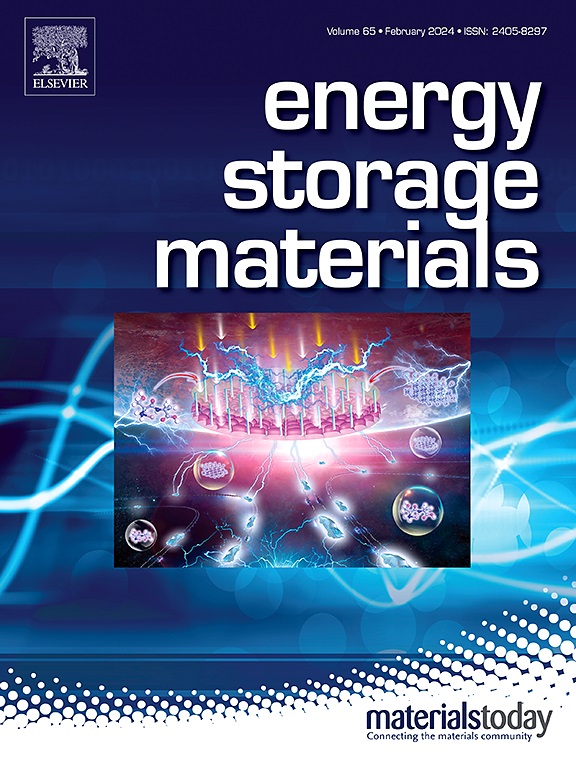定向连续多孔结构的直墨书写3D微电池用超厚微硅阳极
IF 20.2
1区 材料科学
Q1 CHEMISTRY, PHYSICAL
引用次数: 0
摘要
3D微电池具有可定制和厚电极设计,对于小型化和专业化电子设备至关重要。然而,厚三维微电极的实际实施经常受到离子传输缓慢和内外应力下机械不稳定性的挑战。在这里,我们使用原位定向冷冻辅助直接墨水书写3D打印方法开发了耐压超厚微si 3D微电极。这种方法可以构建高达2.7 mm的超厚电极,实现14.0 mAh cm-2的超高面容量。由于形成了定向连续的多孔微观结构,3d打印的厚电极表现出卓越的耐压能力,提供了高达3.04 MPa的高压缩模量。定向孔结构不仅能有效抵抗外部应力,减缓微硅体积变化,还能显著增强离子扩散,与非定向孔结构相比,速率能力和循环稳定性都有所提高。该研究提出了一种可靠的方法来制造具有高机械和电化学性能的耐压超厚3D微电极,为定制3D微电池的应用铺平了道路。本文章由计算机程序翻译,如有差异,请以英文原文为准。


Highly pressure-resistant and high-rate ultrathick micro-Si anodes for 3D microbatteries via direct-ink-writing of directionally continuous porous microstructure
3D microbatteries, featuring customizable and thick electrode designs, are crucial for miniaturized and specialized electronic devices. However, the practical implementation of thick 3D microelectrodes is often challenged by sluggish ion transport and mechanical instability under external and internal stresses. Here, we developed pressure-resistant ultrathick micro-Si 3D microelectrodes using an in-situ directional freezing-assisted direct-ink-writing 3D printing approach. This approach enables the construction of ultrathick electrodes up to 2.7 mm, achieving an ultrahigh areal capacity of 14.0 mAh cm-2. The 3D-printed thick electrodes demonstrate remarkable pressure-resistant capability due to the formation of directionally continuous porous microstructure, providing a high compression modulus of ∼3.04 MPa. The directional pore microstructure not only effectively resists external stress and mitigates micro-Si volumetric changes but also significantly enhances ion diffusion, resulting in improved rate capability and cycle stability compared to the non-directional one. This study presents a reliable method for fabricating pressure-resistant ultrathick 3D microelectrodes with high mechanical and electrochemical performances, paving the way for customized 3D microbattery applications.
求助全文
通过发布文献求助,成功后即可免费获取论文全文。
去求助
来源期刊

Energy Storage Materials
Materials Science-General Materials Science
CiteScore
33.00
自引率
5.90%
发文量
652
审稿时长
27 days
期刊介绍:
Energy Storage Materials is a global interdisciplinary journal dedicated to sharing scientific and technological advancements in materials and devices for advanced energy storage and related energy conversion, such as in metal-O2 batteries. The journal features comprehensive research articles, including full papers and short communications, as well as authoritative feature articles and reviews by leading experts in the field.
Energy Storage Materials covers a wide range of topics, including the synthesis, fabrication, structure, properties, performance, and technological applications of energy storage materials. Additionally, the journal explores strategies, policies, and developments in the field of energy storage materials and devices for sustainable energy.
Published papers are selected based on their scientific and technological significance, their ability to provide valuable new knowledge, and their relevance to the international research community.
 求助内容:
求助内容: 应助结果提醒方式:
应助结果提醒方式:


